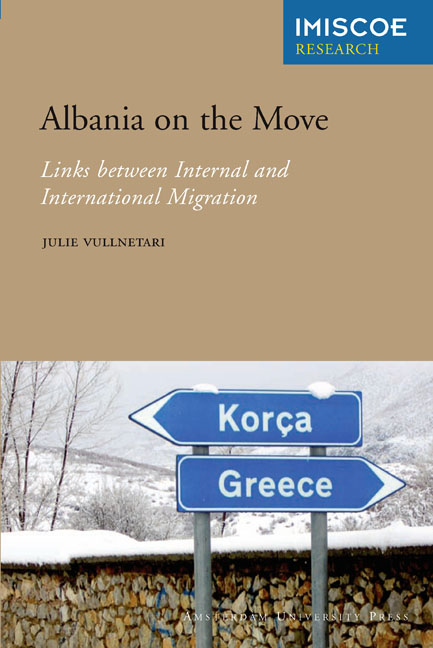Book contents
- Frontmatter
- Dedication
- Contents
- List of Tables, Figures and Photos
- Abbreviations
- Preface
- 1 Introduction
- 2 The Migration-Development Nexus
- 3 Albanian Migration and Development
- 4 Leaving Home: Migration Patterns and Dynamics
- 5 Across the Border: Migrants in Thessaloniki
- 6 Family, Migration and Socio-economic Change
- 7 Migration and Albania's Dynamic Transformation
- 8 Conclusions and Recommendations
- Notes
- References
- Other IMISCOE Titles
4 - Leaving Home: Migration Patterns and Dynamics
Published online by Cambridge University Press: 19 January 2021
- Frontmatter
- Dedication
- Contents
- List of Tables, Figures and Photos
- Abbreviations
- Preface
- 1 Introduction
- 2 The Migration-Development Nexus
- 3 Albanian Migration and Development
- 4 Leaving Home: Migration Patterns and Dynamics
- 5 Across the Border: Migrants in Thessaloniki
- 6 Family, Migration and Socio-economic Change
- 7 Migration and Albania's Dynamic Transformation
- 8 Conclusions and Recommendations
- Notes
- References
- Other IMISCOE Titles
Summary
This is the first in a sequence of four results chapters, which discuss internal and international migration in the Albanian context, the relationship between the two and their combined impact on development in Albania. The chapters are based on empirical material collected in the course of my DPhil fieldwork. The aim of the present chapter is to map the patterns of international and internal migration emanating from the migrants’ area of origin in rural south-east Albania, including their various features and interlinked sequencing. The differences between these two migration types are analysed in terms of migrants’ profiles, migration regimes, geographical and socio-cultural distance, cost-opportunity structure and legal status linked to migration policy. The sequencing, on the other hand, is chartered using King's (in King & Skeldon 2010) ‘Migration pathways’ diagram. These post-1990 migratory flows from the study villages are discussed against the background of the communist years and the ‘transition’ to the capitalist market society, both of which frame the reasons and motivations for these moves, as explained in the previous chapter.
General patterns and destinations
International migration
Migration from my study area has been part of life for centuries (Tirta 1999). Migration throughout the Ottoman Empire, especially to Greece, Egypt and Romania, was later followed by overseas emigration, primarily to the US and Australia. This continued until the closing of Albania's borders in the late 1940s. During the communist years, geographical proximity to the ‘outside world’ made it possible for a small number of individuals, mostly men, to defect to the West via Greece and Macedonia. Their families suffered the serious consequences of internal exile and imprisonment. Most of these defectors finally settled in North America and Australia. In an ironic twist of fate, others who were keen to leave Albania then, decided to remain in the country when the borders opened and they were free to leave. Bilbil, 55, and his family suffered time in prison and years of exile to remote mountainous areas because of their failed attempt to defect to Greece in the late 1960s. Once they were able to move freely after 1990, they worked in Greece for a while and decided instead on settling in Tirana, where they now live.
- Type
- Chapter
- Information
- Albania on the MoveLinks between Internal and International Migration, pp. 107 - 144Publisher: Amsterdam University PressPrint publication year: 2012



